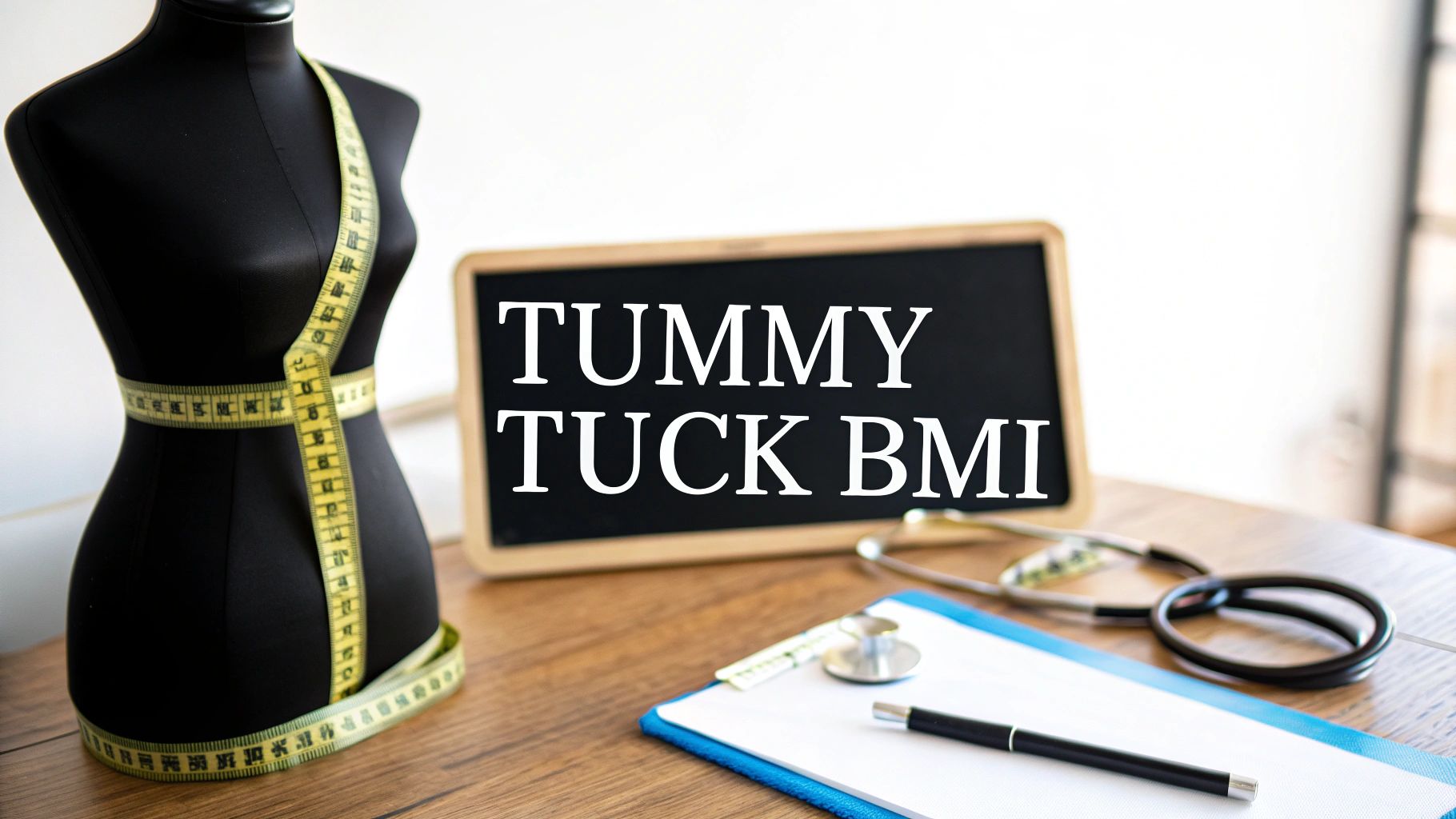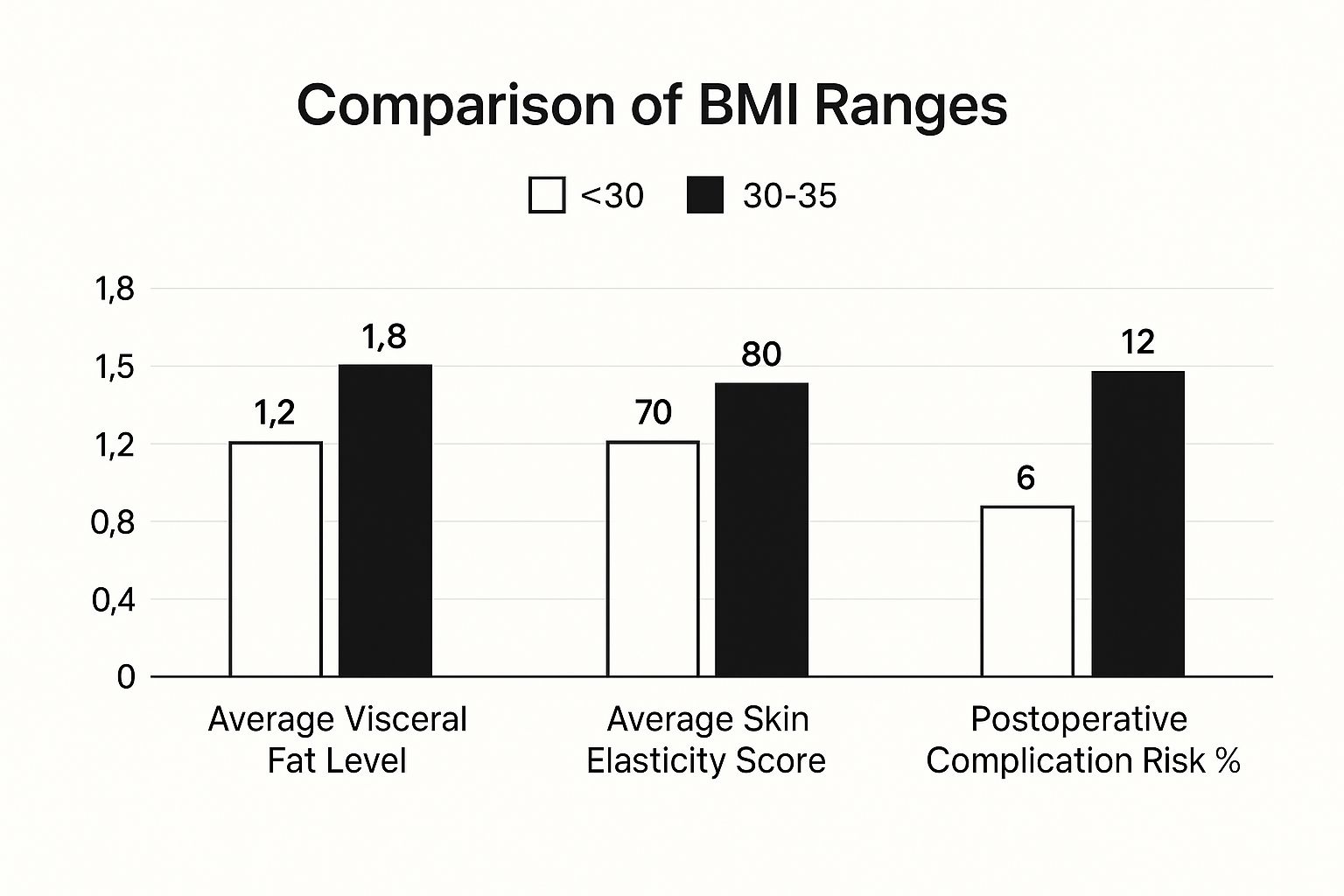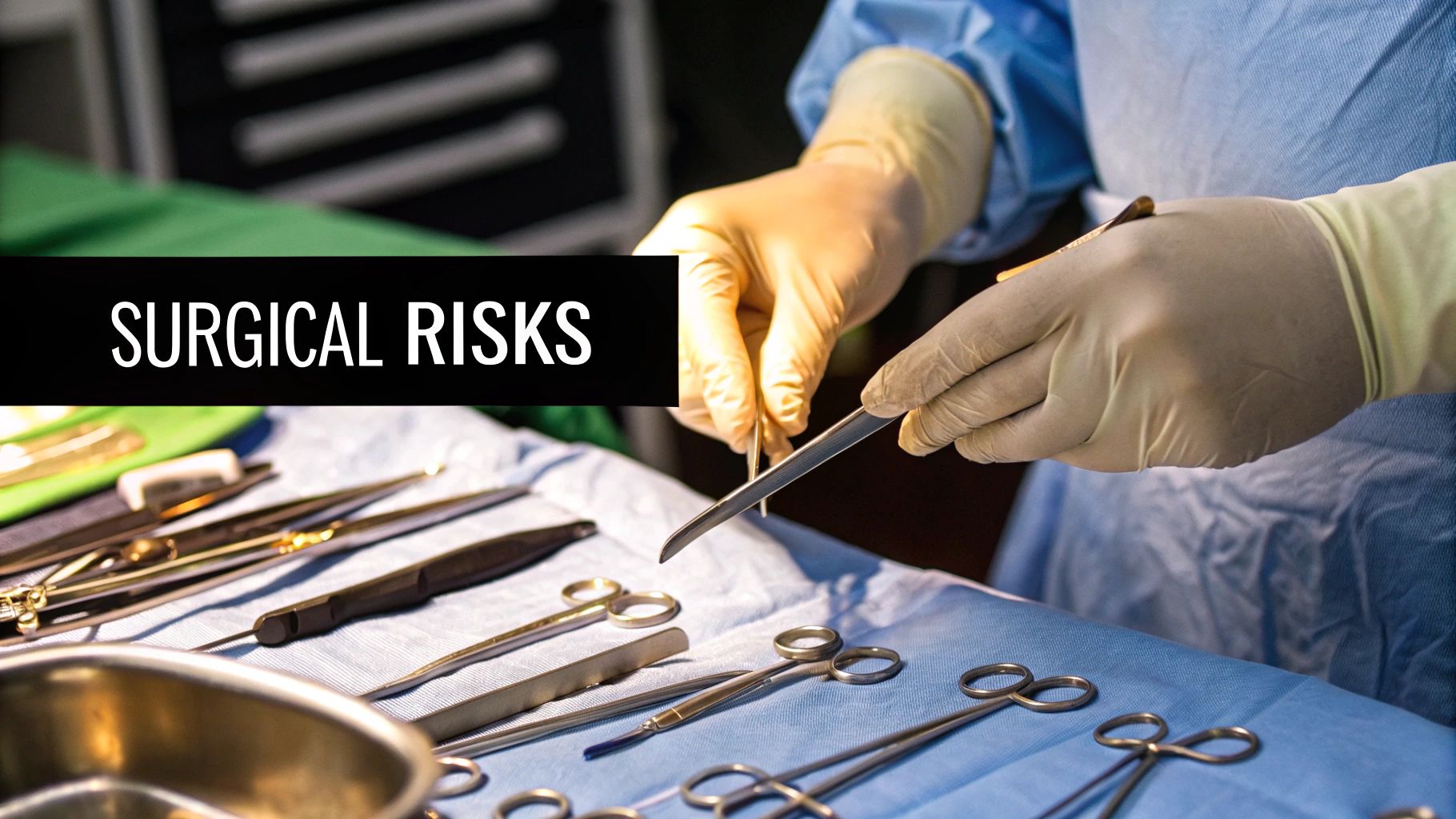
December 10, 2025
A Patient's Guide to Nonsurgical Cosmetic Procedures
Explore popular nonsurgical cosmetic procedures like Botox and fillers. Learn how they work, the benefits, costs, and what to expect from an expert guide.
Oct 21, 2025

When you're thinking about a tummy tuck, one of the first things a surgeon will bring up is your Body Mass Index, or BMI. The magic number they're generally looking for is a BMI under 30. This isn't an arbitrary cutoff; it's the range that consistently leads to the safest procedures and the most stunning, long-lasting results.
While some surgeons might consider patients with a BMI up to 35, the universal advice is to get to a stable, healthy weight before going under the knife. Think of it as preparing the canvas before the artist starts painting.

So, why all the focus on BMI? It’s not about judging your weight. Instead, your surgeon uses it as a practical tool to gauge safety and predict your outcome. It’s one of the most reliable metrics we have.
A tummy tuck, or abdominoplasty, is a body contouring procedure, not a weight-loss one. Its job is to get rid of stubborn excess skin and tighten up the underlying abdominal muscles. For the procedure to be a true success, your surgeon needs a stable foundation to work with. Being at a healthy BMI gives them that predictable canvas.
From a surgeon's perspective, a higher BMI is a red flag for potential complications. This isn’t a gut feeling; it’s based on years of data. An elevated BMI can increase the risks of everything from infection and blood clots to poor wound healing and anesthesia-related issues. Your surgeon uses this number as a first-pass assessment to make sure your body can handle the stress of surgery and the recovery process that follows.
For decades, the sweet spot for a tummy tuck has been a BMI somewhere between 18.5 and 30. Patients in this range tend to heal faster and have fewer complications. That said, some surgeons may work with patients up to a BMI of 35, but only after a very thorough health screening to rule out other weight-related risk factors. You can find more detailed information about tummy tuck eligibility to see where you might fit.
A stable BMI doesn't just improve your safety—it directly impacts the quality and longevity of your surgical results. It ensures the surgeon is sculpting and tightening tissues on a frame that is less likely to change dramatically post-surgery.
To give you a clearer picture, surgeons often think about candidacy in terms of BMI categories. This table breaks down what each range generally means for your tummy tuck journey.
This framework isn't meant to be rigid, but it helps set realistic expectations right from the start. Knowing where you stand allows you to have a much more productive conversation with your surgeon. Together, you can create a personalized plan that puts your health first while working toward your aesthetic goals.
Think of a tummy tuck like getting a custom-tailored suit. For the best possible fit, the tailor needs a consistent frame to work with. In the same way, plastic surgeons can achieve the most precise and lasting results when a patient's body is at a stable, healthy weight. This is where the idea of a BMI "sweet spot" really comes into play.
For an abdominoplasty, the gold standard is a BMI under 30. This isn't just an arbitrary number; it's a guideline based on years of experience, all aimed at ensuring patient safety and beautiful aesthetic outcomes. When your BMI is in this range, your body is simply better prepared for a smooth surgical experience and a much easier recovery.
So, why is a BMI below 30 considered the ideal benchmark for tummy tuck candidates? It all boils down to a few key biological advantages that have a direct impact on the surgery's success.
This infographic does a great job of comparing key health metrics across different BMI ranges, which really drives home why surgeons prefer patients to be in that lower-risk zone.

As you can see, just moving from a BMI under 30 into the 30-35 range can significantly increase the chances of complications and negatively affect things like skin quality.
What happens if your BMI falls between 30 and 35? This is what we often consider a "gray area," where your eligibility for surgery becomes a much more personalized, case-by-case decision. Your surgeon will need to do a more thorough health evaluation to figure out if you can proceed safely.
A surgeon’s decision in this range really hinges on your complete health profile. Things like being a non-smoker, having any chronic health conditions well-managed, and showing a history of stable weight can definitely work in your favor.
The global trend among plastic surgeons is to strongly encourage patients to reach a stable, healthy weight before the procedure. It's the best way to ensure safety and get the kind of results you're dreaming of. While a BMI under 30 is the ideal, some surgeons might accept patients with a BMI between 30 and 35 if they are otherwise in excellent health and fully understand the elevated risks involved.
This careful consideration is especially critical for people who have already put in the hard work of significant weight loss and are looking for that final step in their transformation. You can explore the nuances of body contouring after weight loss in our detailed guide.

A surgeon’s first and most important job is to keep you safe. Period. When we talk about the ideal BMI for tummy tuck surgery, the guidelines aren't there to be exclusive or judgmental. They are purely about minimizing risk and setting you up for a smooth, successful outcome.
Going into a major procedure like an abdominoplasty with a high BMI isn’t just a minor concern; it brings a set of well-documented health challenges to the table. It affects everything from how your body handles anesthesia to how well your incision heals in the weeks that follow.
Think of your circulatory system as a highway, delivering oxygen and nutrients that are vital for healing. When there's a significant amount of fatty tissue, that highway gets a lot longer and more congested. The blood supply has to work much harder to reach the surgical area, which can slow everything down.
This is why patients with a BMI over 30—and especially over 35—face a significantly higher chance of running into problems. It's not just a possibility; it's a statistical reality backed by years of surgical data.
Here are some of the most common issues we see:
If your surgeon recommends postponing your surgery until you reach a lower BMI, please know it’s not a rejection. It’s a protective measure. They want to ensure your body is in the best possible shape to handle the surgery and heal beautifully.
The data really brings the issue into focus. The overall complication rate for tummy tucks is around 4%, which is already a bit higher than some other cosmetic surgeries. But that number doesn't tell the whole story.
When a patient's BMI is 30 or higher, the risk climbs dramatically. In fact, one study found that for patients with a BMI of 40 or more, the complication rate could skyrocket to as high as 46.9%. You can learn more by digging into these tummy tuck statistics for yourself.
The table below breaks down how these risks change with BMI.
Seeing these numbers side-by-side makes it clear why surgeons are so firm about BMI guidelines. Understanding this helps you become a true partner in your own surgical journey. Hitting that target BMI isn't just a hoop to jump through—it's the single most important step you can take toward a safe procedure and the beautiful, long-lasting results you deserve.
https://www.youtube.com/embed/b74RKY9y9Ig
Finding out your BMI is higher than the ideal range for a tummy tuck isn't a rejection—it's actually the first step on a new, empowering path. Think of this as the prep work, the crucial phase of building a solid foundation before an artist starts sculpting. This is your chance to get your body ready for an incredible result.
The goal here isn't about speed. It’s about health and sustainability. Crash diets can rob your body of the very nutrients it needs to heal well. Plus, the weight often comes right back, which can undo the beautiful work your surgeon performs. Instead, this is about building healthy habits that will stick with you for life.
The most important first move you can make is to get some expert advice. Partnering with a nutritionist or a registered dietitian is a game-changer. They can map out a personalized plan that helps you lose fat while holding onto the lean muscle that's so vital for a strong recovery.
Your pre-surgery diet should be packed with specific nutrients that are known to help the body heal.
Many women looking into a tummy tuck are also navigating their post-baby bodies. You can find excellent, gentle strategies for losing pregnancy weight that fit perfectly with a steady, sustainable mindset. Pairing this with a good exercise routine—a mix of cardio and strength training—will do more than just help you hit your goal weight. It will boost your circulation and overall fitness, making for a much smoother recovery.
So, why are surgeons so insistent on seeing a stable weight for a few months before booking your surgery? It all comes down to predictability and safety. When your weight isn't fluctuating, your surgeon can be incredibly precise, knowing exactly how much skin and tissue to remove to create a beautiful, natural contour.
Maintaining your goal weight for at least three to six months proves that your new, healthier habits are here to stay. This gives your surgeon the confidence that your amazing results will last. Big weight swings after surgery can stretch the skin and affect the muscle repair, so stability is key.
This whole preparation phase is a critical part of your transformation. By focusing on your overall health now, you’re doing more than just getting ready for an operation. You're setting the stage to enjoy your results for a lifetime. For a deeper dive, check out our complete guide on how to prepare for surgery and walk into your procedure with total confidence.

While the BMI for tummy tuck guidelines are a crucial starting point, that number is only one piece of a much larger puzzle. A skilled surgeon never makes a decision based on a single metric. They look at you as a whole person, conducting a thorough evaluation to make sure the procedure will be both safe and successful for your unique body.
Think of your BMI as the initial screening. If your number is in the right range, it gets you in the door for a conversation, but the real assessment is far more personal. It’s a deep dive into your health history, lifestyle, and what you hope to achieve.
A surgeon’s number one priority is your safety, and that means taking a close look at your general health. Any chronic conditions need to be well-managed to keep surgical risks as low as possible.
Here are a few key things we always review:
A surgeon isn't just looking at your health today; they're assessing your body's ability to heal tomorrow. A healthy, non-smoking patient at a stable weight is setting themselves up for the smoothest possible recovery and the best outcome.
It's also really important to have realistic expectations about what a tummy tuck can and cannot do. This surgery is fantastic for removing subcutaneous fat—that’s the soft, pinchable layer of fat sitting right under the skin.
However, a tummy tuck cannot touch visceral fat.
Visceral fat is the hard, internal fat packed around your abdominal organs. It’s what can give some people a firm, protruding belly, and it can only be reduced through diet and exercise. Understanding this distinction is key to being happy with your final results. For some patients, we might even discuss alternatives or additions to a traditional surgery, such as advanced technologies like BodyTite body contouring.
In the end, your surgeon is a bit like a detective, putting together all the clues—your BMI, health status, fat distribution, and personal goals—to build a complete picture. This comprehensive approach ensures that an abdominoplasty tummy tuck is truly the right choice, paving the way for a safe procedure and beautiful, lasting results.
Getting that flat, toned stomach you’ve been dreaming of is an incredible feeling, but the work doesn't stop once the surgery is over. Think of your tummy tuck as hitting the reset button—a powerful head start. To make sure your results last a lifetime, you have to protect that investment.
The single most important factor? Weight stability. A tummy tuck does wonders by removing stubborn skin and tightening up the muscle wall, but it can't prevent future weight gain or loss from changing your shape.
Major swings on the scale after your surgery can, unfortunately, start to undo the beautiful work your surgeon performed. If you gain a significant amount of weight, the fat cells that remain in your abdomen and elsewhere will get bigger. This can stretch out the very skin your surgeon meticulously tightened.
This kind of fluctuation can lead to:
On the flip side, losing a lot of weight after your procedure can also create problems, sometimes resulting in new areas of sagging skin. The ideal BMI for a tummy tuck isn't just a number to hit before surgery; keeping your BMI in a healthy range is the secret to making your results last.
Your tummy tuck is more than a procedure; it's the ultimate motivation to lock in a healthier lifestyle. Let your amazing new look inspire you to build habits that keep you feeling fantastic for years to come.
Keeping your results doesn't mean you have to live a life of extremes. It's really about weaving small, smart habits into your everyday routine.
Eat for Fuel and Enjoyment: Ditch the crash diets. Instead, focus on a balanced plate filled with lean protein, fresh fruits and veggies, and whole grains. Consistent, mindful eating is the key to keeping your weight steady.
Keep Your Body Moving: Regular exercise is non-negotiable. Find something you enjoy! A mix of cardio—like brisk walking, swimming, or cycling—and some strength training will help you maintain that firm muscle tone and keep your metabolism humming.
By committing to these healthy habits, you're not just getting a temporary fix. You're ensuring your tummy tuck results are a permanent part of your new, confident self.
Even when you know the ideal BMI for tummy tuck surgery, you probably still have a few specific questions swirling around. Let's tackle some of the most common ones that come up in my practice to help you see how these guidelines work in the real world.
While a BMI under 30 is what we aim for, some surgeons, myself included, will consider patients with a BMI up to 35. This isn't a hard and fast rule, though—it's always a case-by-case decision that hinges on a very thorough health evaluation.
Things like being a non-smoker, having great overall fitness, and no weight-related health problems can definitely work in your favor. The only way to know for sure is to come in for a consultation where we can truly assess your personal risk profile and talk about your goals.
This is a big one, and it's so important to get it right: a tummy tuck is all about contouring your body, not about losing weight.
The only weight you'll lose is from the actual skin and fat that's removed, which usually only adds up to about 4 to 11 pounds. The most stunning, long-lasting results happen when you're already at or very close to your ideal weight before stepping into the operating room.
The goal of an abdominoplasty is to refine your shape, not to lower the number on the scale. Approaching the procedure with this mindset is key to being satisfied with your outcome.
Absolutely. It's just as important to be healthy on the lower end of the scale. Surgeons will take a close look at patients with a very low BMI, typically anything below 18.5, for potential health red flags.
Being underweight might mean you don't have enough fat reserves for proper healing, or it could point to underlying health issues we need to address first. My top priority is always making sure you're healthy enough for a safe procedure and a smooth recovery.
At Cape Cod Plastic Surgery, Dr. Fater and our team are committed to giving you personalized, honest guidance on your aesthetic journey. If you have more questions about whether a tummy tuck is right for you, we invite you to schedule a consultation with us today.

December 10, 2025
Explore popular nonsurgical cosmetic procedures like Botox and fillers. Learn how they work, the benefits, costs, and what to expect from an expert guide.

December 10, 2025
Exploring Your Breast Surgery Choices: From Cancer Treatment to Cosmetic Enhancements

December 9, 2025
Tired of looking tired? Uncover what causes under eye bags, from genetics to lifestyle, and explore expert-backed prevention tips and treatment options.